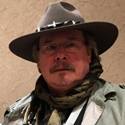February 10, 2006
Bigfoot Field Note #1***– Part IV
Casting Bigfoot tracks in snow is not as difficult as people think or make it out to be. Hardest part is going to be finding them.
Sure you can take to surfing the internet and find dozens of sites describing the process using molten sulfur to the adding of a pinch of Potassium Sulfate* and spray waxing the impression first, but I really think people that want to do this should understand the process and experiment on their own. Being presented with a Bigfoot track is kind of intimidating… you sure don’t want to screw it up.
The aircraft tooling business I have been employed in for the past 20 or so years has given me just that… an understanding of the process and material. You see each impression presents a slightly different set of problems to overcome and there is no way someone can describe it all in writing. Nor can you follow even the manufacturers directions to the letter and expect the results you want**. It is both an art and a science. Experience in the field is what you really want but here are some references anyway…
Casting in Snow with Sulfur
Measuring and Assessing Species Diversity III: Identifying Mammals by their Sign
I wanted to address this issue in one of my posts here, casting a track in snow, so I ordered some spray wax. It cost me $16 for a can of the stuff and a $25 shipping and hazardous handling fee. Wow! Wonder how many tracks I will be able to cast with it? Wonder what cold weather will do to its contents?
Snow arrived here in Washington, fast, cold, heavy and deep this year. The snow wax was going to take 6 weeks to arrive. Well, ok, I had a theory that by altering the method I cast regularly with just a little that I wouldn’t be needing anything I already didn’t have. I bet that snow wax stuff will be more a bother with clogging, freezing up or running out just at the wrong times then any type of real help… so off I went.
Blewett Pass is where I ended up. I kind of like the place and there has been about 5 or 6 Bigfoot sightings and track finds there (sorry…unpublished). There were many places there that had perfect snow patches to experiment in. If I was right I needed to setup a camera and record casting a track in snow.
Well I have to tell you… it worked just like I thought it would. I did mix some of the local snow into the water first (dumping out any crystals that didn’t melt before adding Hydrocal B-11 plaster). I also used my two-part process in casting… a light and thin splash coat before a much thicker and viscous backup batch. It also doubled the time it took to cure but… well you be the judge… Give it some time to load… it is a big animated gif.
* This chemical is suppose to retard freezing, lowering the temperature water will stay a liquid and also drastically increase the speed at which plaster cures.
** This is the one big problem I have with the work of Matt Crowley. Granted, he has done some excellent work and may follow the advice of the plaster manufacturer to the letter and low and behold he is getting some pretty strange looking things on the surface of his casts. He now attributes some of this to what has been found on the bottoms of Bigfoot casts made in the 60’s, 70’s, heck, all the way to the present. He now believes that what has been called dermal ridge patterns could actually just be these strange artifacts he has generated… following the manufacturers recommendations. The plaster I use is about 2/3 plaster to 1/3 water. It has to be mixed with water that is 50 F., not 100 F. It has to be mixed by hand, adding the plaster to the water and first allowing it to soak a bit, removing air from the small particles of plaster… not with a stick and immediately after pouring the plaster in.
*** Other websites have taken my techniques and posted the descriptions of casting bigfoot tracks as their own… look at the techniques used or should I say written about. Then look at this series, with pictures proving the process. I’m flattered.
 About Rick Noll
About Rick Noll
Rick Noll has been actively searching for the Sasquatch since 1969 and continues his pursuit with extended field trips into the Pacific Northwest's most remote regions. Rick has worked with Peter Byrne, René Dahinden, Grover Krantz, John Green, Jeff Meldrum and the BFRO during all this. He helped with many documentaries on the subject including Animal X: The Skookum Expedition and Sasquatch: Legend Meets Science.
Email • Twitter •
Filed under Artifacts, Bigfoot, Bigfoot Hunter, Cryptozoology, Evidence, Forensic Science, Sasquatch
